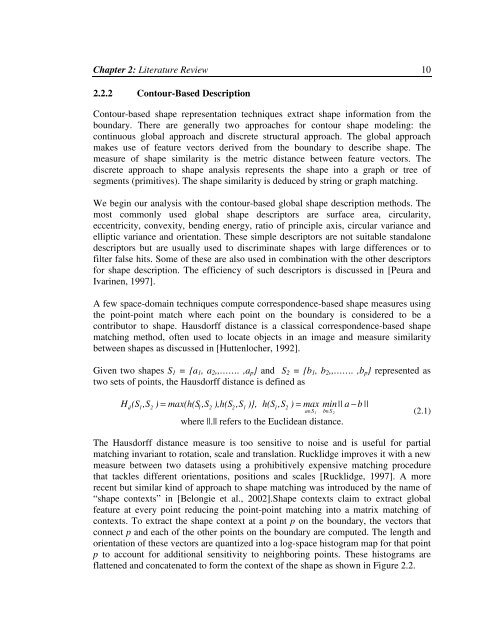To the Graduate Council: I am submitting herewith a thesis written by ...
To the Graduate Council: I am submitting herewith a thesis written by ...
To the Graduate Council: I am submitting herewith a thesis written by ...
Create successful ePaper yourself
Turn your PDF publications into a flip-book with our unique Google optimized e-Paper software.
Chapter 2: Literature Review 102.2.2 Contour-Based DescriptionContour-based shape representation techniques extract shape information from <strong>the</strong>boundary. There are generally two approaches for contour shape modeling: <strong>the</strong>continuous global approach and discrete structural approach. The global approachmakes use of feature vectors derived from <strong>the</strong> boundary to describe shape. Themeasure of shape similarity is <strong>the</strong> metric distance between feature vectors. Thediscrete approach to shape analysis represents <strong>the</strong> shape into a graph or tree ofsegments (primitives). The shape similarity is deduced <strong>by</strong> string or graph matching.We begin our analysis with <strong>the</strong> contour-based global shape description methods. Themost commonly used global shape descriptors are surface area, circularity,eccentricity, convexity, bending energy, ratio of principle axis, circular variance andelliptic variance and orientation. These simple descriptors are not suitable standalonedescriptors but are usually used to discriminate shapes with large differences or tofilter false hits. Some of <strong>the</strong>se are also used in combination with <strong>the</strong> o<strong>the</strong>r descriptorsfor shape description. The efficiency of such descriptors is discussed in [Peura andIvarinen, 1997].A few space-domain techniques compute correspondence-based shape measures using<strong>the</strong> point-point match where each point on <strong>the</strong> boundary is considered to be acontributor to shape. Hausdorff distance is a classical correspondence-based shapematching method, often used to locate objects in an image and measure similaritybetween shapes as discussed in [Huttenlocher, 1992].Given two shapes S 1 = {a 1 , a 2 ,,……. ,a p } and S 2 = {b 1 , b 2 ,,……. ,b p } represented astwo sets of points, <strong>the</strong> Hausdorff distance is defined asHd(S1,S2) = max(h(S1,S2),h(S2,S1)}, h(S1,S2) = max min|| a − b ||a∈ S1 b∈S 2(2.1)where ||.|| refers to <strong>the</strong> Euclidean distance.The Hausdorff distance measure is too sensitive to noise and is useful for partialmatching invariant to rotation, scale and translation. Rucklidge improves it with a newmeasure between two datasets using a prohibitively expensive matching procedurethat tackles different orientations, positions and scales [Rucklidge, 1997]. A morerecent but similar kind of approach to shape matching was introduced <strong>by</strong> <strong>the</strong> n<strong>am</strong>e of“shape contexts” in [Belongie et al., 2002].Shape contexts claim to extract globalfeature at every point reducing <strong>the</strong> point-point matching into a matrix matching ofcontexts. <strong>To</strong> extract <strong>the</strong> shape context at a point p on <strong>the</strong> boundary, <strong>the</strong> vectors thatconnect p and each of <strong>the</strong> o<strong>the</strong>r points on <strong>the</strong> boundary are computed. The length andorientation of <strong>the</strong>se vectors are quantized into a log-space histogr<strong>am</strong> map for that pointp to account for additional sensitivity to neighboring points. These histogr<strong>am</strong>s areflattened and concatenated to form <strong>the</strong> context of <strong>the</strong> shape as shown in Figure 2.2.
















